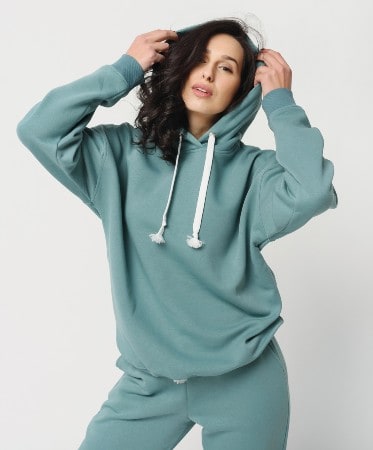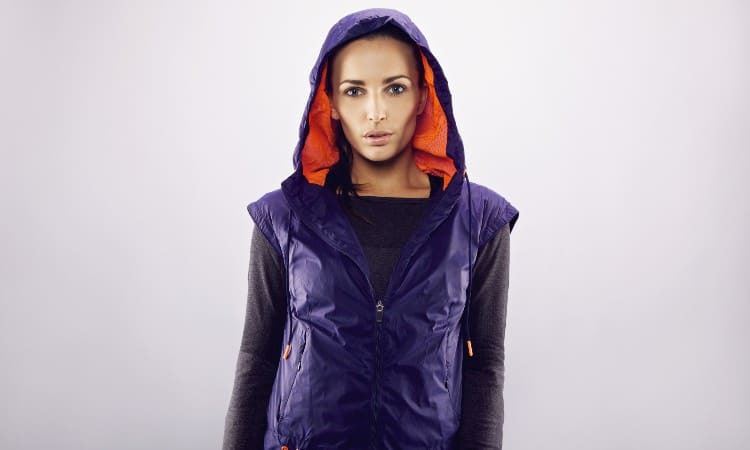Unless you live in a tropical climate, you almost certainly have one or two jackets and hoodies stored away for the winter months. Hoodies and jackets can both keep you toasty warm on a brisk fall day. But when you compare hoodie vs jacket, what is the difference between these two popular garments?
The main difference between hoodies and jackets is that a jacket provides protection from the weather and a hoodie does not. Another key difference is that hoodies feature a soft knitted fleece material, and jackets often feature a weatherproof material. Both garments layer on top of other clothing and provide warmth.
In this article, you will find out the key characteristics of both hoodies and jackets. You will find out what makes these garments different from each other. Finally, you will find tips for when to wear a hoodie and when to wear a jacket!

Quick Navigation
- What is a Hoodie?
- What is a Jacket?
- Hoodie vs Jacket: Key Differences
- What’s the Difference Between Hoodie and Jacket?
- Is a Hoodie a Jacket or Sweater?
- Hoodie vs Sweatshirt
- Do Hoodies Have Zippers?
- Jacket and Hoodie Combo
- What is a Jacket with a Hood Called?
- What Does Wearing a Hoodie Say About You?
- Should You Wear a Hoodie or a Jacket?
What is a Hoodie?
 A hoodie is an outerwear made of knitted fleece with an attached hood. It often has a baggy shape, a muff or pouch for the hands, and long sleeves with ribbed knit cuffs. For the past several decades, it has gained immense popularity and now reigns supreme as one of the top kinds of comfort clothing, surpassed only by jeans and yoga pants!
A hoodie is an outerwear made of knitted fleece with an attached hood. It often has a baggy shape, a muff or pouch for the hands, and long sleeves with ribbed knit cuffs. For the past several decades, it has gained immense popularity and now reigns supreme as one of the top kinds of comfort clothing, surpassed only by jeans and yoga pants!
Most of the time, a hoodie is used as a top layer or “outerwear” over a shirt. It has a casual, slouchy appearance that makes it perfect for wearing around the home or on a college campus. Typically, this garment has an oversized shape that allows the hem to fall considerably below the waist and for the shoulder seams to drape past the shoulder.
Another key element of the classic hoodie is the kind of cloth it contains. Hoodies almost always feature a soft knitted fleece, sometimes called sweatshirt fleece. This material has a smooth, knitted structure on one side and soft fuzzy fleece on the reverse side.
This type of cloth has a lot of stretch because of the knitted structure, which uses loops of intertwined threads instead of over-under crossed threads. The fuzzy side comes from a special machine that uses sandpaper or wire brushes to scrape at the underside of the knitted material, causing tiny fabric fibers to break free and form a soft mat on the material’s surface.
Can you wear a hoodie outside? Yes, but only under certain conditions. It will keep you warm when layered over top of a t-shirt, but it will not protect you from rain, snow, or stiff winds.
Of course, as with all garment styles, you will find a lot of variation within the hoodie category. For example, you can find types that zip up the front, kinds that have pockets instead of a hand pouch, and styles that have a more fitted shape instead of a baggy cut. But all hoodies have a hood and almost all use sweatshirt fleece.
What is a Jacket?
 A jacket is a type of outerwear intended for wearing outdoors that protects from the elements. You can think of a jacket as a lighter version of a coat. It uses lighter materials and often has a closer cut than a bulky coat, but it will provide some warmth and weather resistance.
A jacket is a type of outerwear intended for wearing outdoors that protects from the elements. You can think of a jacket as a lighter version of a coat. It uses lighter materials and often has a closer cut than a bulky coat, but it will provide some warmth and weather resistance.
Jackets often have a hem at or above the hips and almost always have long sleeves. They usually fasten up the front using a zipper or snaps. They typically feature pockets and may or may not provide a hood.
Jackets can come in all kinds of cuts and use many different types of material. Popular clothing types include denim, leather, nylon, and wool.
Typically, you wear a jacket while outdoors. It does not form part of your outfit once you come back inside the way a sweater might.
Why is a jacket called a jacket? In the Middle Ages, people in France called a lightweight tunic a “jaquet.” This word turned into “jaquette” in modern French, where it means a light type of outerwear, just like “jacket” does in English!
The term jacket does have a more generic meaning, though. You can find dozens of different types of jackets in popular use today, ranging from chef’s jackets to suit jackets to a nylon windbreaker or jogging jacket.
The extreme overuse of the term “jacket” makes it a little trickier to pinpoint exactly what characterizes this type of garment. It’s very much like how the term “shirt” can mean anything from a t-shirt to a fancy silk blouse! For this reason, you sometimes also see jackets broken into two categories: stylistic kinds like blazers and practical kinds like hiking or jogging jackets.
In general, you can classify a jacket as a garment intended to wear outside that has a fitted shape, long sleeves, and a front closure.
Hoodie vs Jacket: Key Differences
Check out this chart to discover the key differences between a hoodie and a jacket at a glance!
| Hoodie | Jacket | |
|---|---|---|
| Material | Knitted fleece with brushed reverse and knit outer side. | Varies a lot, ranging from denim to leather to nylon. |
| Hood | Always includes a hood. | May or may not include a hood. |
| Zipper | Occasionally has a front zipper closure, but usually has a pull-on style. | Always has a front closure, usually a zipper. |
| Pouch/pockets | Usually features a front pouch or muff for the hands. | Usually features pockets at the front. |
| Weather Resistance | Provides very little weather resistance. | Provides good weather resistance but not as much as a coat. |
| Indoor/Outdoor | Intended more for indoor use. | Intended for outdoor use. |
| Cost | Usually around $20-$40 | Varies a lot, typically more than a hoodie |
| Best Used For | Casual home wear or informal settings like a bonfire or college campus. | Wearing outdoors as protection. |
What’s the Difference Between Hoodie and Jacket?

The biggest difference between a hoodie and a jacket is the type of fabric used and the cut of the garment. You can also find other key differences, such as the average cost of each and the popular use of each garment.
That said, both garment types do share some similarities as well. For instance, they both keep you warm in cold temperatures. They also both typically serve as outerwear meant to layer on top of shirts or other clothing.
Type of Material
Hoodies and jackets almost always use different kinds of material. Hoodies pretty much always contain knitted fleece, often called sweatshirt fleece. Jackets, in contrast, can use all kinds of different materials, usually medium-weight fabric or lightweight, weatherproof fabric such as nylon.
Hoodie fabric, otherwise known as sweatshirt fleece, has a soft fuzz on the inside that feels nice and cozy against your skin. The knitted outer surface provides a bit of comfortable elasticity to the garment. This all makes sense since this garment functions primarily as a comfortable, at-home style these days!
As a side note, you can find hoodies made out of varying weights of sweatshirt fleece. Super heavy-duty knitted fleece can make bulky, heavy hoodies that provide as much warmth as a winter coat. But most of the time, they feature a light and stretchy type of sweatshirt fleece that will keep you cozy inside as a sweater would.
Jacket fabric gets more complex as you can find anything from denim to nylon in this category. But most jacket fabric does come in a heavy enough weight to provide some insulation for outdoor weather. Or, in the case of special synthetic materials, it may have lightweight but offer wind resistance, water resistance, and insulation because of its design.
Hood/No Hood
A hoodie always has a hood, while a jacket may or may not feature a hood. In fact, the hood attached to the neckline of a hoodie is what distinguishes it from the broader category of sweatshirts.
Hoodie hoods almost always use the same knitted fleece as the rest of the garment, but in this case, the hood often has two layers with the knitted side facing out on both the inside and outside of the hood. Most of the time, this hood also comes with a drawstring to pull the hood open or closed.
Jackets often do not have a hood, but some do, especially kinds designed for intense outdoor use such as hiking or camping. In this case, the hood may come with detachable snaps so you can take it on and off at your convenience.
Zipper or No Zipper
Jackets almost always have a zipper closure up the center front of the garment, but hoodies rarely use a zipper. Some jackets may use a slightly offset zipper that sits more to one side than on the center front. Others may even use buttons or snaps instead of a zip.
Most hoodies do not use any closure, as the loose fit and stretchy fabric make this the perfect pull-on or pull-over garment. But in some cases–especially with heavy-duty hoodies–you will find a zipper closure up the center front.
Pouch or Pockets
Jackets usually have pockets, and a hoodie usually features a pouch.
One of the distinguishing features of most hoodies is the pouch or muff located near the waistline of the garment. You can also see this special feature called a “kangaroo pocket,” which is the most fun of the names! This pouch is roomy enough that you can easily slide both inside it at once or stash your phone there as you run into the store to buy groceries!
Jackets almost never use a pouch, as it would get in the way of the zipper closure. Instead, they typically have pockets in the side seams of the garment. Some highly weather-resistant jackets may even provide small zippers to seal the pockets shut in bad weather.
Weather Resistance
Jackets typically provide much more weather resistance than hoodies. Hoodies offer warmth and some protection from a chilly breeze, but the open, stretchy texture of the knitted fleece does not provide a serious windbreak. Likewise, sweatshirt fleece will soak up rain or snow and quickly become clammy and cold against your skin.
Many jackets use a medium-weight fabric that provides more protection from the wind. They may also use special weather-resistant materials such as polyester or nylon to keep you dry in a rain storm!
Indoor or Outdoor Apparel
Both hoodies and jackets work best as outerwear layered on top of other garments, but jackets serve better as outdoor apparel, while hoodies work best when worn indoors.
This may seem confusing because you almost certainly grab your hoodie for a quick neighborhood walk in the fall or to run out to the store on a chilly spring day. Hoodies can provide the warmth you need outdoors, but only in the right conditions! It can’t protect you from freezing temperatures or bad weather like rain, snow, or harsh winds.
On the other hand, a jacket is designed specifically to wear outdoors as a protective covering that you take off again once you get inside. This garment almost always provides some protection from outdoor elements. The only exception to this rule is the subcategory of stylistic jackets, such as suit jackets, which may work better indoors and will not provide much warmth or protection.
Cost
Jackets often cost more than hoodies, but this can vary depending on the style and brand of both garments.
The average price of a hoodie is about $35, though this can easily go up to $50 or more for a customized or luxury brand model. A heavy-duty style will cost quite a bit more as well.
The average price for a jacket depends on the style of the jacket. Hiking jackets typically cost around $50, while suit jackets could easily cost as much as $300.
Best Used For
Jackets are best for outdoor wear, while hoodies work best indoors or outdoors for casual and informal settings.
Overall, jackets have a more fitted and formal appearance than hoodies. This holds true for outdoor jackets as well as for indoor jackets like blazers.
Because of a hoodie’s bulky, stretchy shape, it falls firmly into the “informal” category. Think of it this way– you could wear a jacket to the office, but not a hoodie! At least, not unless you work for Google or a super informal company.
Is a Hoodie a Jacket or Sweater?

When you compare a jacket vs hoodie vs sweater, the biggest difference lies in the kind of cloth used in each of these cold-weather garments. Hoodies use sweatshirt fleece, jackets come in lots of medium-weight fabrics such as denim, and sweaters contain yarn knitted or crocheted into the shape of the garment.
You can also see a clear difference in the style of each garment. Hoodies have a baggy sweatshirt shape with an attached hood, a drawstring, and a muff for the hands. Jackets have a more fitted shape and a zipper up the center front. Sweaters can come in all shapes and sizes, but they are always soft wool, acrylic, or cotton yarn knitted or crotched in loops and patterns to form their lacy pattern.
While hoodies and jackets serve as outerwear, sweaters can be worn in place of a shirt and don’t work well for outdoor wear in chilly weather.
Hoodie vs Sweatshirt
A hoodie is a kind of sweatshirt that has an attached hood. Technically, “hoodie” is just a slang term that has become so popular that it entered the common lexicon.
Generally speaking, when you say sweatshirt, you mean a pullover top made of sweatshirt fleece with a round crewneck collar. When you say hoodie, you mean a pullover garment made out of sweatshirt fleece that has an attached hood and a muff.
Do Hoodies Have Zippers?

Hoodies do not usually have zippers, but you can find a few that do, called zip-up hoodies. You see this style most often in heavy-duty kinds made of thick sweatshirt fleece that can keep you warm outside even in very cold temperatures. Sometimes, these heavy-duty versions even have a quilted lining on the inside!
Does this mean that a zip-up hoodie is a jacket? Well, the definition of what exactly makes a “jacket” is a bit fuzzy, as you now know! But usually, a zip-up hoodie still has a loose and baggy fit that distinguishes it from the typically close fit of most jackets.
Jacket and Hoodie Combo
You can find two types of jacket-hoodie combos in popular use today: the style of layering a jacket over a hoodie and the type of garment that features the body of the jacket and the sleeves and hood of a hoodie.
It may not be haute couture, but in some settings, you can get away with layering a denim or leather jacket on top of a hoodie. This look presents an urban and casual vibe that you often see paired with sneakers and jeans. Besides setting a certain informal tone, this outfit also keeps you super warm because you get the weather resistance of the jacket and the cozy warmth of the hoodie!
The other popular type of jacket-hoodie combo is promoted by brands like Levi’s, which sells a jacket featuring a denim trucker’s jacket with sleeves made of sweatshirt fleece and an attached hood. This look also has an informal style.
What is a Jacket with a Hood Called?

A jacket with a hood is just called a jacket most of the time. Some types of jackets with hoods may have special names like an anorak or parka, rain jacket, or hiking jacket. The hood does not define a jacket, though some sub-categories of jackets tend to have hoods more often than others.
Of course, not every jacket comes with a hood.
What Does Wearing a Hoodie Say About You?

Wearing a hoodie can say many different things about you, ranging from a youthful appearance to a statement about race and equality or even a symbol of resistance against authority figures. Over time, different cultural groups have assigned many different meanings to hoodies.
- The most popular use for hoodies is simply to wear something casual, cozy, and comfortable around your home or neighborhood. This type of loungewear has remained in style for decades now because pretty much everyone loves a good soft hoodie!
- Like t-shirts, hoodies come with all kinds of funny, cute, or personalized sayings and pictures printed onto them. This means you can use this garment to promote something that matters to you, like your favorite band, cause, or video game.
- Probably because hoodies are so cozy, they form a staple of student wardrobes and have become a symbol of “youthful” clothing because of this. If you visit a college campus, every second or third student will probably sport a hoodie in chilly weather!
- Hoodies also play a big role in urban street style. For this reason, you will find an argument that wearing a hoodie can lead to racial profiling in some situations.
- Some schools forbid students from wearing hoodies because they say the loose fit of the garment and the concealing hood can lead to dangerous incidents like concealed weapons or an adult sneaking into the school.
Generally, you can tailor the message you send by wearing a hoodie, depending on what you pair with it. For example, if you wear ripped jeans and boots with your hoodie, you may present more of a street style. If you wear leggings and uggs with your hoodie, you will look more like a poster for a pumpkin spice latte.
Should You Wear a Hoodie or a Jacket?
Whether you should wear a hoodie or a jacket depends on several factors, including how comfortable you want to feel, the formality of the event you plan to attend, and the weather outside.
If you plan to stay outside for a long time, you may want to consider wearing a jacket. You should also wear a jacket rather than a hoodie any time you see a chance of rain in the forecast. A jacket will usually keep you better protected from the elements.
If you have a clear fall sky overhead or plan to hang out indoors with friends all day, a hoodie may feel more comfortable and less constraining. The loose, stretchy fit of this garment makes it much better comfort clothing than most jackets.
That said, you also want to consider the formality of any event you plan to attend before choosing between a jacket and a hoodie. Hoodies have a very informal appearance best suited to low-key events like study groups, bonfires, or school sports games. Jackets have a fitted shape and work better to wear to the office, a party, or a formal event.
Jackets and hoodies will both keep you warm! But the bottom line is that jackets work better outdoors than hoodies. Hoodies feel more comfortable than jackets and work better for informal settings.